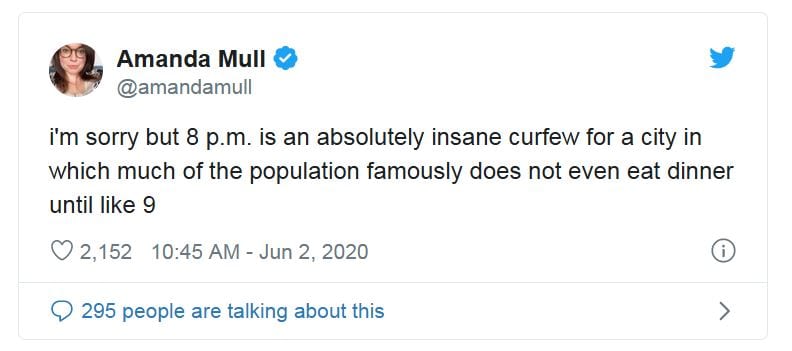June 2, 2024
READER BOOK PLUG: From Frank Miniter, The Year of the Dragon.
AS ALWAYS, LIFE IMITATES SEINFELD: LA Lifeguard Says He Was Punished for Not Flying Pride Flag.
You don’t want to wear the ribbon? You have to wear the ribbon!
RICH LOWRY: EV fail exposes Pete Buttigieg as the little cabinet secretary who couldn’t.
Rarely has a cabinet secretary done so little with such vast resources.
On the CBS show “Face the Nation,” Transportation Secretary Pete Buttigieg had to defend the Biden administration’s woeful record of building new electric vehicle charging stations that are key to unlocking its hoped-for EV nirvana.
Host Margaret Brennan asked how it could be that, with $7.5 billion allocated for this purpose two years ago, the administration has managed to build eight.
Not 8,000, or even 80. Eight.
Buttigieg said President Biden plans on building 500,000 chargers by the end of the decade, and — implying this is some sort of accomplishment — “the very first handful of chargers are now already being physically built.”
It’s true that eight is better than zero, and the administration is now only 492,000 chargers away from its goal rather than 500,000 away.
At this rate, though, the Emperor Hadrian wouldn’t have finished his wall prior to the fall of the Western Roman Empire, and we’d still be constructing the Hoover Dam* to this day.
Evergreen:

* Well, they can’t build those, either: As Joel Kotkin wrote in 2010, “When FDR commissioned projects such as the Tennessee Valley Authority, he literally brought light to darkened regions. The loyalty created by FDR and Truman built a base of support for liberalism that lasted for nearly a half-century. Today’s liberals don’t show enthusiasm for airports or dams — or anything that may kick up some dirt. Deputy Assistant Secretary of the Interior Deanna Archuleta, for example, promised a Las Vegas audience: ‘You will never see another federal dam.’”
AIR CONDITIONING? HHS announces new tool to help residents deal with extreme heat.
GOODER AND HARDER, CALIFORNIA: Shocking new footage emerges of huge wooden ‘shantytown’ built in Democrat-run city whose name is byword for crime and urban decay:
Shocking footage has emerged showing a gigantic ‘shantytown’ that has sprung up in Oakland, as the California city’s slide into crime-ravaged squalor continues.
Michael Oxford, the host of CaliBased, posted a video on May 31 of massive temporary houses built along service roads that open up into main roads in Hooverville, Oakland.
The footage showed trash strewn around scores of houses that were built of wood, tarp and other discarded materials.
Particularly shocking was just how large the ‘shantytown’ is, with a lengthy stretch of road in the Bay Area city covered with the makeshift dwellings.
Oxford could be heard calling the area a ‘shantytown’ that is ‘absolutely mindboggling,’ as he remarked how ‘insane it is that [city officials] allow this.’
He captioned the video, ‘Parts of Oakland are worse than a third world country. They just allow people to live in absolute squalor, wherever they choose.
‘This looks like Hooverville during the great depression. Welcome to Oakland’s very own Gavinville.’
Tom Wolf, a former homeless man who is a recovering heroin and fentanyl addict from San Francisco, also re-shared the same video and said, ‘Worse than any shanty in the third world. You know how we got here? Drugs.’
Oakland’s descent into a dystopian hellhole comes despite its enviable location in the San Francisco Bay area – one of the most naturally-beautiful locales in the United States.
And while both Oakland and neighboring San Francisco are home to huge numbers of wealthy people thanks to the tech boom of nearby Silicon Valley, both cities have become associated with filth and crime increasingly blamed on progressive policy.
“Gavinville?” Time to update an oldie but a goodie Photoshop:
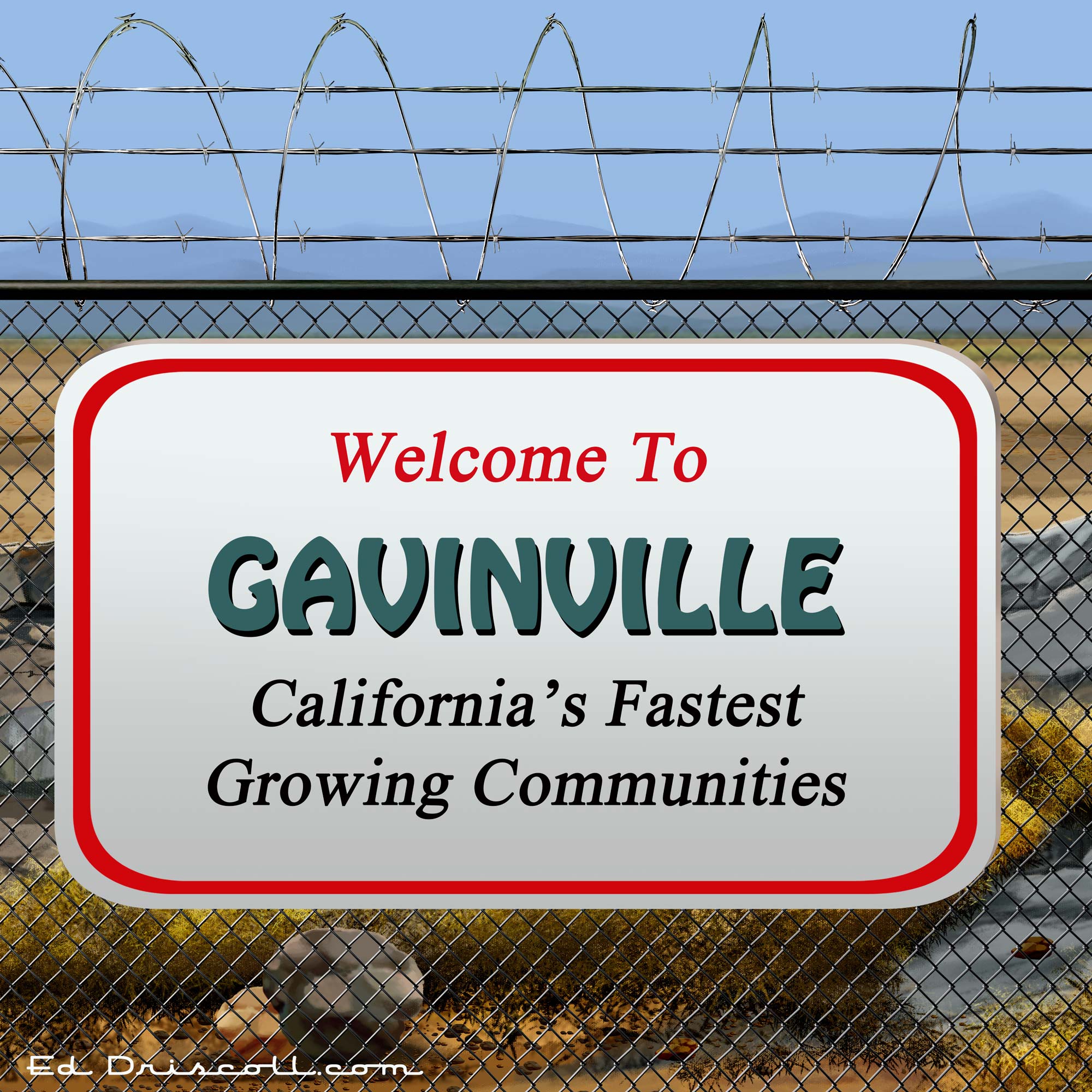
Oakland’s last Republican mayor left office in 1977.
JON GABRIEL: Trump isn’t the reason why Biden is down in the polls. Inflation is.
It’s tough to change the narrative when every trip to a store, restaurant* or barber shop serves as another anti-Biden campaign ad.
According to a recent Reuters/Ipsos poll, Americans prefer Trump’s economic policies to Biden’s by a 10-point margin. Abstract warnings about the end of democracy won’t distract moms and dads from worrying about their weekly budget.
When it comes to the economy, Arizona is doing better than most states. We rank fourth in job growth, unemployment is below the national average, and the Phoenix area has the lowest inflation in the U.S.
And yet. It just doesn’t feel like boom times, nor will it in November.
According to the Joint Economic Committee, the average Arizona household spends $1,202 more per month than it did when Biden was inaugurated. Over that same time frame, they’ve cumulatively spent an extra $29,052 thanks to inflation.
A lot of things are going wrong** for Biden, from immigration to foreign wars to concerns about his age. But his biggest problem is that things simply cost too much.
He can’t stop voters from noticing that.
* As Kate Hyde joked on Twitter last week:
“No Burger King tonight, kids. We’re strapped on cash so we’re going to Ruth’s Chris.” https://t.co/1JXfmVbBvK
— Kate Hyde (@KateHydeNY) May 27, 2024
** Hard to think of illegal immigration as “going wrong” for Biden, when it’s been one of his (and/or his handlers’) goals from day one:
● Jared Bernstein, member of Biden’s Council of Economic Advisors: “One thing we learned in the 1990s was that a surefire way to reconnect the fortunes of working people at all skill levels, immigrant and native-born alike, to the growing economy is to let the job market tighten up. A tight job market pressures employers to boost wage offers to get and keep the workers they need. One equally surefire way to sort-circuit this useful dynamic is to turn on the immigrant spigot every time some group’s wages go up.”
● Former Trump administration senior adviser Stephen Miller: Biden’s Immigration Plan Would “Erase America’s Nationhood.”
● “Labour wanted mass immigration to make UK more multicultural, says former adviser. Labour threw open Britain’s borders to mass immigration to help socially engineer a ‘truly multicultural’ country, a former Government adviser has revealed.”
HARSH, BUT FAIR:
Man the new White House make over looks pretty sweet. (I kid). pic.twitter.com/BHtKXrWEbN
— Seán Ono Lennon (@seanonolennon) June 2, 2024
“I’m sadder than I let on.”
FOUR YEARS AGO TODAY, THE PIVOT BEGAN: ‘Did I miss the memo?’: Hospital workers in full PPE applaud George Floyd protesters as they march past.
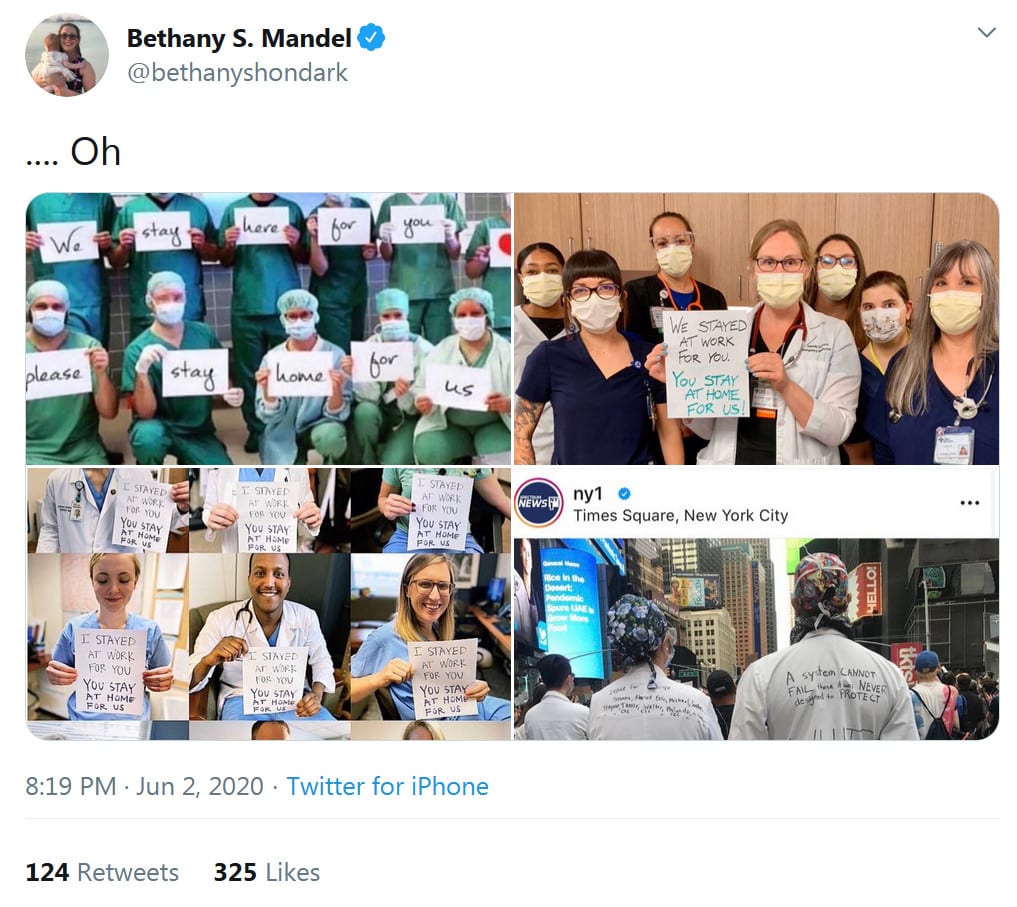
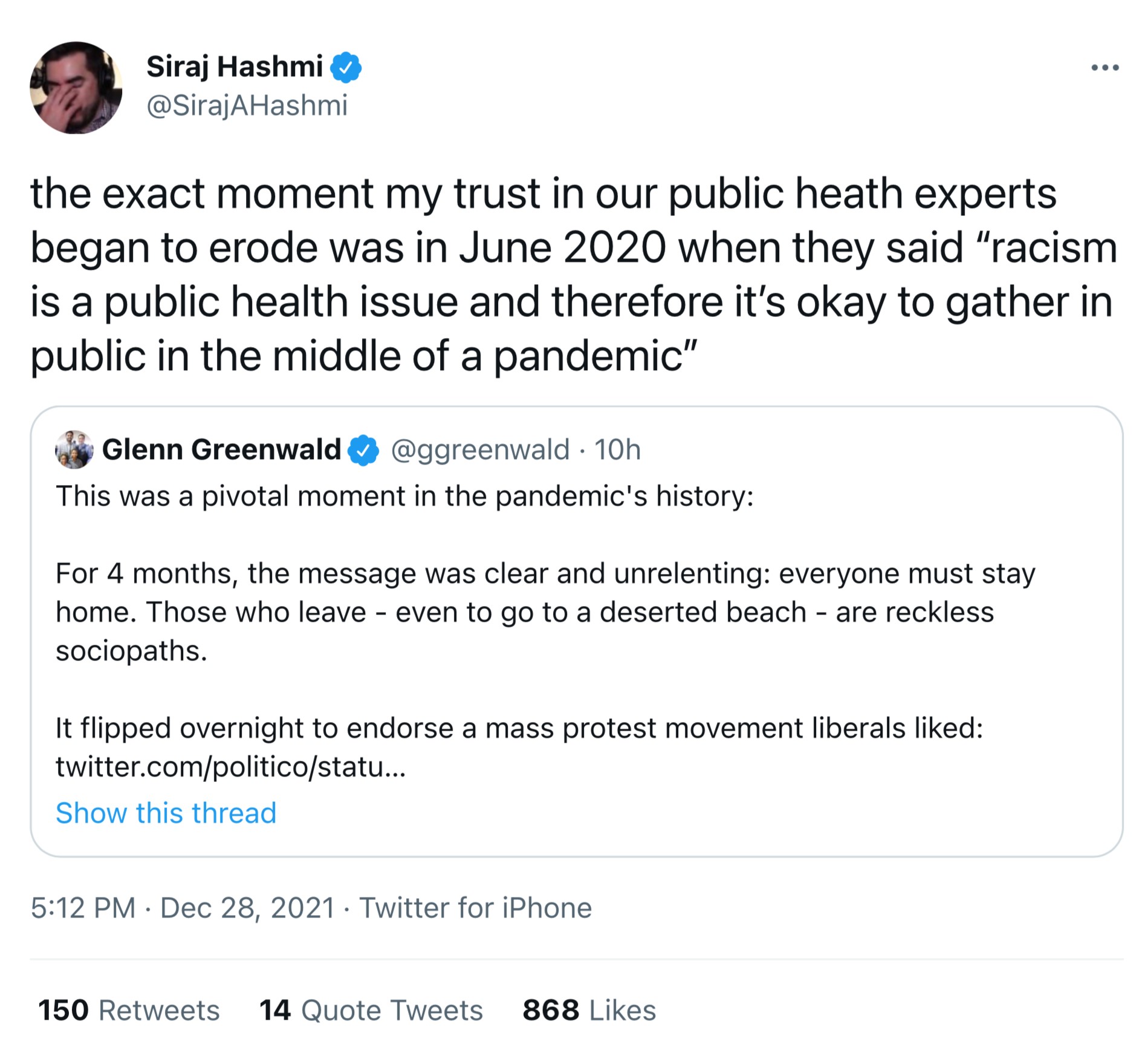
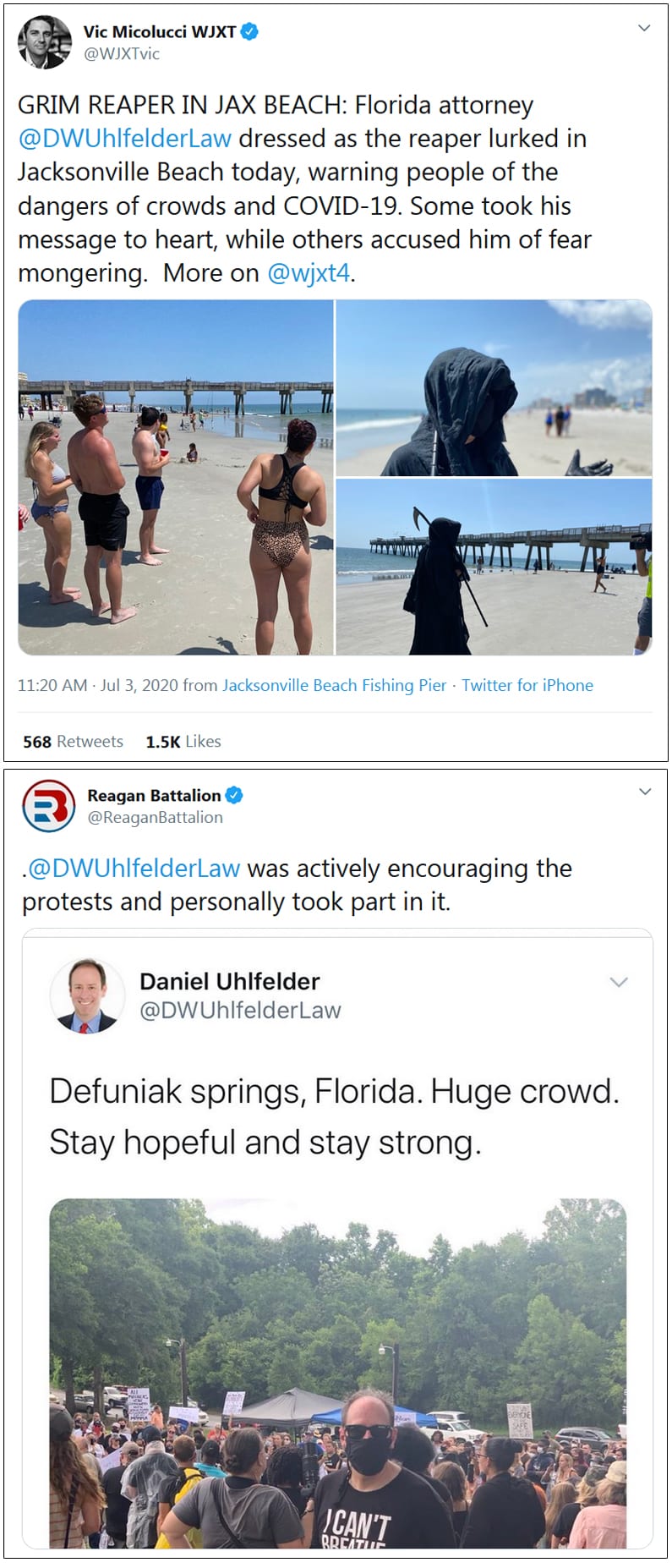
As Greenwald writes in his follow-up tweet, “That episode single-handedly destroyed trust in public health officials, proving they’d politicize their expertise when convenient. Corporate media celebrated a douchebag-lawyer shaming families at deserted beaches, then — overnight! — cheered densely packed street protests.”
QED: Shot: Grief and COVID-19: Mourning our bygone lives.
The COVID-19 pandemic is an epidemiological crisis, but also a psychological one. While the situation provokes anxiety, stress and sadness, it is also a time of collective sorrow, says Sherry Cormier, PhD, a psychologist who specializes in grief and grief mentoring. “It’s important that we start recognizing that we’re in the middle of this collective grief. We are all losing something now.”
Many people are reckoning with individual losses, including illness and death due to the novel coronavirus, or loss of employment as a result of economic upheaval. But even people who haven’t lost anything so concrete as a job or a loved one are affected, Cormier says. “There is a communal grief as we watch our work, health-care, education and economic systems — all of these systems we depend on — destabilize,” she says.
—The American Psychological Association, April 1st, 2020.
Chaser: APA’s action plan for addressing inequality.
Dear Colleagues,
We are writing to you while still reeling from the tragic murder of George Floyd by Minneapolis police and the ongoing protests, which are reverberating in a shockwave throughout our nation and around the world.
These recent events present us with an urgent challenge—as an association, discipline and profession, and individual psychologists—to bring our expertise to bear to address the range of underlying problems these events represent from discrimination to racism, which have resulted in long-standing social, economic, and political inequalities, from police brutality, to the disproportionate spread of the coronavirus among black and brown people, to the soaring unemployment rates among communities of color.
APA is urging psychologists to share their thoughts and recommendations for using the power of psychology to address the “pandemic of racism,” both in the short and long term. As part of that process, we must also examine our role as a field and as an association in perpetuating these ills.
—The American Psychological Association, June 2nd, 2020.
Note the photos atop those Webpages. The April 1st post is illustrated by photos of an elderly white woman looking frustrated in her apartment, and a young black woman staring wistfully into the distance outside the window of her apartment, with the photos separated by a white dividing line to emphasize both persons’ isolation from the world. Contrast that with the photo of the massed protestors carrying “Black Lives Matter” placards atop the June 2nd post.
NPR also pivoted on June 2nd, 2020:

The DNC-MSM and local mayors turned on a dime from enforcing hard-line lockdown rules and shaming anyone who went to church or got a haircut, to letting rioters congregate with impunity. As Bill de Blasio was quoted four years ago today, “When you see…an entire nation, simultaneously grappling with an extraordinary crisis seated in 400 years of American racism, I’m sorry, that is not the same question as the understandably aggrieved store owner or the devout religious person who wants to go back to services.”
Flashbacks:
● After telling GOP to downsize convention due to COVID-19, N.C. governor marches in crowded protest.
● De Blasio: Large Group Protests Are Acceptable, Religious Observances Are Not.
● Welcome to protest season, where the cause changes but the tactics stay the same.
LIMITED TIME DEAL: Anker 100W USB C Charger Block(GaN II), 3 Port Fast Compact Wall Charger for MacBook Pro, MacBook Air Etc. #CommissionEarned
THE NEW SPACE RACE: Chang’e-6 lands on far side of the moon to collect unique lunar samples.
SEGREGATION NOW, SEGREGATION TOMORROW, SEGREGATION FOREVER: The Dean of UCLA Medical School Says It Does Not Discriminate Based on Race. His Own Research Center Runs a Minorities-Only Fellowship. The ‘iDIVERSE’ program bars white and Asian researchers from applying.
LIMITED TIME DEAL: CAROTE 21Pcs Pots and Pans Set, Nonstick Cookware Sets. #CommissionEarned
June 1, 2024
EVEN A FLATWORM IS SMART ENOUGH TO TURN AWAY FROM PAIN: Swedes Embrace Nuclear & Join Europe’s Grand Rejection Of Wind & Solar Transition.
WOMEN SHOULD BE FREE, FROM THE RIVER TO THE SEA: (NSFW) Bill Maher Provides College Kiddies With Helpful Lesson in Exactly What They’re Supporting.
Kids, if you want to change the world and not just tie up Monday morning traffic, this is the apartheid that desperately needs your attention: The #GenderApartheid. pic.twitter.com/0Ajep3JUnN
— Bill Maher (@billmaher) June 1, 2024

